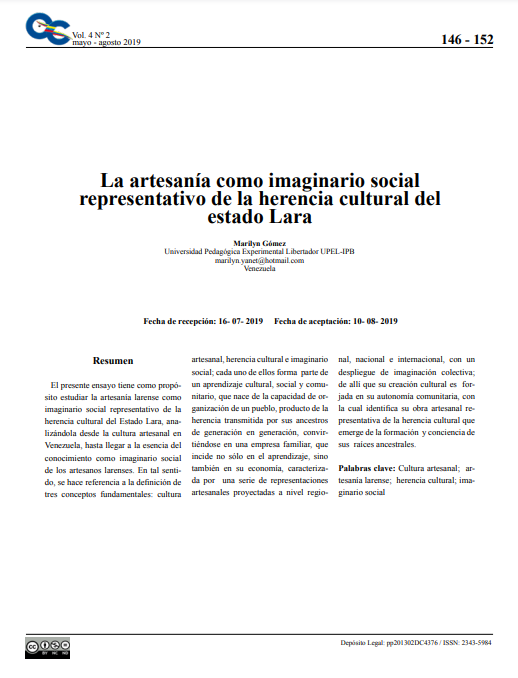The crafts as a representative social imaginary of the cultural heritage of the Lara state
Keywords:
Artisanal culture, larense crafts, cultural heritage, social imaginaryAbstract
The purpose of this essay is to study Larean crafts as a social imaginary representative of the cultural heritage of the Lara State, analyzing it from artisanal culture in Venezuela, until reaching the essence of knowledge as a social imaginary of Larean artisans. In that sense, reference is made to the definition of three fundamental concepts: artisanal culture, cultural heritage and social imaginary; Each of them is part of a cultural, social and community learning, born from the capacity of organization of a people, product of the inheritance transmitted by their ancestors from generation to generation, becoming a family business, which affects not only learning, but also in its economy, characterized by a series of craft representations projected at regional, national and international levels, with a collective imagination display; Hence, his cultural creation is forged in his community autonomy, with which he identifies his artisan work representative of the cultural heritage that emerges from the formation and awareness of its ancestral roots.
Downloads
References
Cabrera, D. (2000). Imaginario social, comunicación e identidad colectiva. Disponible en http://www.portalcomunicacion.com/dialeg/paper/pdf/143_cabrera.pdf.Consultado el 10/06/2019.
Castoriadis, C. (1998). Institución imaginaria de la sociedad: España: Tusquets. P. 371.
Contreras, S (2018). Herencia cultural: definición, características y ejemplos. Disponible en https://www.lifeder.com/herencia-cultural/ Consultado 21/06/2019.
Ford, A. (1999). La marca de la bestia. Buenos Aires: Norma.p.64
Fressard, O. (2006). El imaginario social o la potencia de inventar de los pueblos. Disponible en Revista Transversal, numero 2. http://www.trasversales.net/t02olfre.htm. Consultado 22/06/2019.
Mattei Müller, M. y Henley, P. (1978). Wapa: la comercialización de la artesanía indígena y su innovación artística: el caso de la cestería panare Caracas: Tecnocolor.
UNESCO (1982). Declaración de México sobre las políticas culturales. Conferencia mundial sobre las políticas culturales. México. Disponible en https://culturalrights.net/descargas/drets_culturals400.pdf. Consultado 24/06/2019.
UNESCO. (1997). Simposio La artesanía y el mercado internacional: Comercio y codificación aduanera. Disponible en: https://docplayer.es/2199524-Simposio-internacional-sobre-la-artesania-y-el-mercado-internacional-comercio-y-codificacion-aduanera-manila-filipinas-6-8-de-octubre-de-1997.html.Consultado 21/0672019.

Downloads
Published
How to Cite
Issue
Section
License

This work is licensed under a Creative Commons Attribution-NoDerivatives 4.0 International License.







